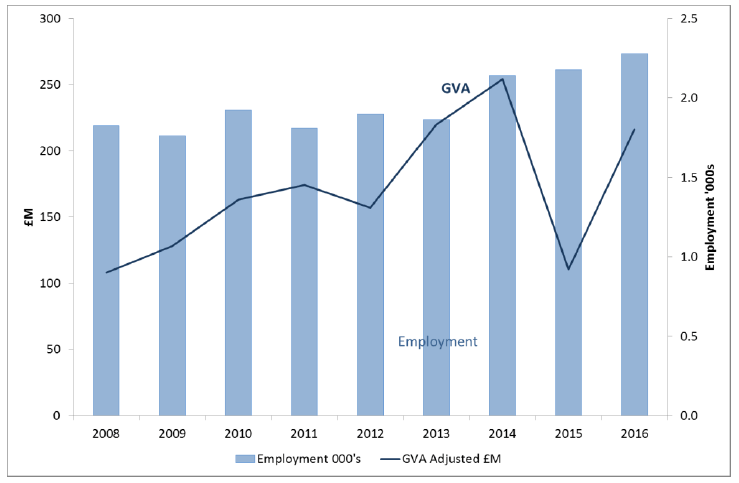Scotland's marine economic statistics 2016
The publication presents economic statistics for industrial categories defined as part of the marine sector.
4. Aquaculture
4.1 Introduction
Aquaculture or fish farming is the breeding, growing and harvesting of plants and animals in water. It can take place in natural water bodies such as ponds, lakes, marshland or brackish water and the ocean. It can also be conducted in tanks, commonly found in fish hatcheries.
Aquaculture production provides a range of seafood products:
- Finfish – salmon, rainbow trout, brown trout and halibut
- Shellfish – mussels, Pacific oysters, native oysters, queen scallops and king scallops
In this section the economic contribution of aquaculture has been estimated using two main data sources: Marine Scotland Aquaculture survey statistics for 2016 and economic data collected to meet DCF requirements. This approach allows for more reliable estimates of economic activity than SABS figures, primarily because the aquaculture surveys is reported for every production site registered as active during the survey year.
The aquaculture survey statistics provide production and employment data, while data collected for DCF provides financial data from a sample survey. Details of the methodology employed are shown in Annex B: Methodology and source data on page 67.
There is a difference of around 20%[4] in the aquaculture GVA statistics extracted from SABS and those drawn from the Marine Scotland Aquaculture Survey Statistics. The Marine Scotland statistics are used here.
4.2 Key economic points
In 2016 aquaculture generated £216 million in GVA: accounting for 0.16 % of the overall Scottish economy, and 6 % of the marine economy.
In terms of employment, aquaculture provided employment for a headcount of 2,300 people, contributing 0.09 % to total Scottish employment, and 3 % of the marine economy employment.
4.3 Aquaculture trends
Table 8: Aquaculture - GVA, turnover, employment and GVA per head, 2008 to 2016 (2016 prices)
| Year | GVA £M | Turnover £M | Employment Headcount 000's | GVA Per Worker £ |
|---|---|---|---|---|
| 2008 | 108 | 415 | 1.83 | 59,028 |
| 2009 | 128 | 488 | 1.76 | 72,780 |
| 2010 | 163 | 617 | 1.92 | 84,752 |
| 2011 | 174 | 656 | 1.81 | 96,255 |
| 2012 | 157 | 594 | 1.90 | 82,689 |
| 2013 | 220 | 729 | 1.86 | 117,855 |
| 2014 | 254 | 763 | 2.14 | 118,705 |
| 2015 | 110 | 683 | 2.18 | 50,713 |
| 2016 | 216 | 797 | 2.28 | 94,833 |
Between 2008 and 2016 aquaculture GVA (adjusted to 2016 prices) doubled while employment increased by 25%.
Aquaculture has been affected by diseases, including sea lice. In 2015 GVA was at its lowest since 2008, which was due to a combination of lower turnover and higher costs as a result of disease challenges. Between 2015 and 2016, although production volume decreased (see Table 24), farmed fish prices rose with the result that GVA for 2016 almost doubled from £110 million in 2015 to £216 million in 2016.
Figure 6 : Aquaculture - GVA and employment, Scotland , 2012 to 2016

Table 24 presents more detailed aquaculture data, including aquaculture breakdown by aquaculture type (fin fish or shellfish).
4.4 Aquaculture by geography
It is not possible to report disaggregated Aquaculture outputs to local authority levels as these become too disclosive. In the Marine Scotland Aquaculture Production Survey Statistics figures are presented by Scottish marine region[5] (SMR) as far as possible. However for the smaller industry sectors (for example, trout or scallops etc.) any geographic disaggregation is disclosive and some regions have had to be merged.
Atlantic salmon production accounts for 95% of all aquaculture. Around 28% of salmon production occurs on the North coast (Marine regions: West Highlands, Moray Firth & North Coast ), one fifth occurs in both the Outer Hebrides and Argyll and Clyde with a little under 10% produced in the Orkney Isles.
Mussels are mostly grown in the Shetland Isles, which accounts for three quarters of all production.
Oyster production accounts for around 1% of all aquaculture value and is largely split between the North Coast group and Argyll and Clyde (around a third of total production in each).
Contact
There is a problem
Thanks for your feedback